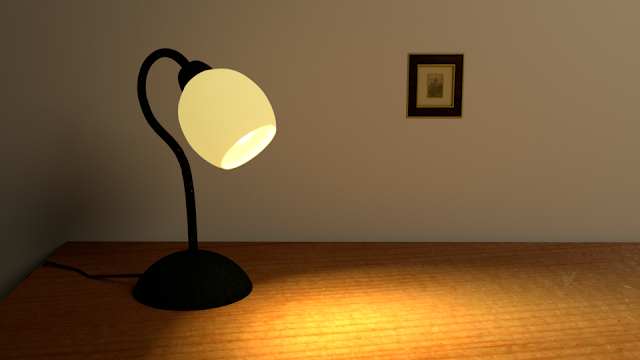Table lamp
As I promised last time, I'm going to talk about my second Blender project - a table lamp shining through a dark room. When I was looking for an idea on what to make, I was stumped, again. And so I looked around my room and (you may start to see a pattern here) I chose the first thing with an interesting enough shape that I could find. Which happened to be this lamp.
At first, I didn't have any ambitions beyond simply modelling the lamp but then it occurred to me that it would look really cool if the lamp was lit. Not a terribly original idea, I know, but I thought - how hard could it be? Really hard, it turns out.
The modelling part was okay-ish. I struggled a bit with proportions because for some reason I couldn't curve the arm correctly and the lamp shade stubbornly refused to be plump enough. So I thought I would use Blender's metric system (instead of the generic one), measure everything, model it according to the spec, and then the rest would come out great, right? Wrong. Because I started using the metric units in the middle of the project, I somehow got the proportions all skewed. Or I didn't set it up properly, that's always a distinct possibility.
Anyway, I finished modelling the lamp and I began thinking about the scene. Lamps are not known for their ability to fly around, so I started designing some simple surface to put it on. Those are usually called tables, and they are made of wood, and I had no idea how to make wood material in Blender. I kept one of the renders with the original material, so you can compare the two.
As you can see, the original material had very little in common with any wooden surface ever, so I looked up a tutorial or two (I can't exactly remember which ones but those from Blender Guru are likely candidates). I used the node editor for the first time, got scared, mixed together some diffuse and gloss textures with a normal map, and closed it as fast as I could. It did the trick, though, so I'm quite happy with the result.
The next part was adding a material to the arm and the base. I couldn't find one that would match exactly what I wanted, so I had to improvise a bit. There is a surprisingly large number of "black with brown spots" materials out there but none of them was what I was looking for. And I'm still ages away from being able to create my own textures.
Now, all of this had turned out rather nicely, but I'm not really satisfied with how the lamp shade is rendered. I tinkered a lot with various light settings but I don't seem to be able to reproduce that glowing quality of a real lamp. I have modelled a light bulb (that is slightly visible in the original render but not in the finished one) because I wanted to simulate the real physical properties of the lamp. I put a spot light inside - mainly to get the reflection on the table. I also gave the light bulb and the lamp shade a material that emits light, but it still isn't good enough, I think.
As I was not able to progress any further with that, I focused on finishing the scene. What I thought would be just a few light touches turned out to be modelling of two new objects (the picture and the cable), putting actual walls around the table (so that the light bounces around somewhat better) and messing around with the lights for ages. I still suspect the picture of casting shadows it definitely should not but I'm not going to discipline it too harshly. Oh, and the cable is not plugged in. Don't tell anyone.
Next time, I'm going the share with you the first part of my "Welcome to the lab" mini-series (do two projects count as a mini-series?), specifically a tube stand with tubes that are filled with glass jelly - er, liquid. Extremely scientific liquid.




Comments
Post a Comment